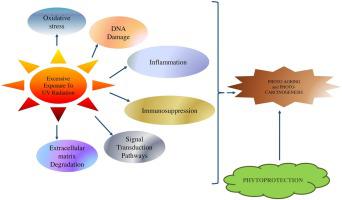Ageing Research Reviews ( IF 13.1 ) Pub Date : 2020-07-25 , DOI: 10.1016/j.arr.2020.101127 Chanchal Garg 1 , Hitender Sharma 1 , Munish Garg 1

|
Excessive exposure of skin to UV radiation triggers the generation of oxidative stress, inflammation, immunosuppression, apoptosis, matrix-metalloproteases production, and DNA mutations leading to the onset of photo ageing and photo-carcinogenesis. At the molecular level, these changes occur via activation of several protein kinases as well as transcription pathways, formation of reactive oxygen species, and release of cytokines, interleukins and prostaglandins together. Current therapies available on the market only provide limited solutions and exhibit several side effects. The present paper provides insight into scientific studies that have elucidated the positive role of phytochemicals in counteracting the UV-induced depletion of antioxidant enzymes, increased lipid peroxidation, inflammation, DNA mutations, increased senescence, dysfunctional apoptosis and immune suppression. The contribution of phytochemicals to the downregulation of expression of oxidative-stress sensitive transcription factors (Nrf2, NF-Kb, AP-1 and p53) and protein kinases (MSK, ERK, JNK, p38 MAPK, p90RSK2 and CaMKs) involved in inflammation, apoptosis, immune suppression, extracellular matrix remodelling, senescence, photo ageing and photo-carcinogenesis, is also discussed. Conclusively, several phytochemicals hold potential for the development of a viable solution against UV irradiation-mediated photo ageing, photo-carcinogenesis and related manifestations.
中文翻译:

用植物化学物质对皮肤进行光保护,以抵抗光氧化应激,光致癌作用,信号转导途径和细胞外基质重塑-概述。
皮肤过度暴露于紫外线辐射会触发氧化应激,炎症,免疫抑制,凋亡,基质金属蛋白酶的产生以及DNA突变,从而导致光老化和光致癌作用的发生。在分子水平上,这些变化是通过几种蛋白激酶的激活以及转录途径,活性氧的形成以及细胞因子,白介素和前列腺素一起释放而发生的。市场上可用的当前疗法仅提供有限的解决方案并表现出若干副作用。本文提供了对科学研究的洞察力,这些科学研究阐明了植物化学物质在抵抗UV诱导的抗氧化酶消耗,脂质过氧化增加,炎症,DNA突变,衰老增加,功能失调的凋亡和免疫抑制。植物化学物质对涉及炎症的氧化应激敏感转录因子(Nrf2,NF-Kb,AP-1和p53)和蛋白激酶(MSK,ERK,JNK,p38 MAPK,p90RSK2和CaMKs)表达下调的贡献,还讨论了细胞凋亡,免疫抑制,细胞外基质重塑,衰老,光老化和光致癌作用。最终,几种植物化学物质具有开发出针对紫外线辐射介导的光老化,光致癌作用和相关表现的可行解决方案的潜力。还讨论了涉及炎症,细胞凋亡,免疫抑制,细胞外基质重塑,衰老,光老化和光致癌作用的p90RSK2和CaMKs。最终,几种植物化学物质具有开发出针对紫外线辐射介导的光老化,光致癌作用和相关表现的可行解决方案的潜力。还讨论了涉及炎症,细胞凋亡,免疫抑制,细胞外基质重塑,衰老,光老化和光致癌作用的p90RSK2和CaMKs。最终,几种植物化学物质具有开发出针对紫外线辐射介导的光老化,光致癌作用和相关表现的可行解决方案的潜力。


























 京公网安备 11010802027423号
京公网安备 11010802027423号